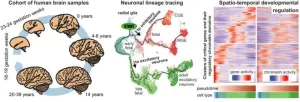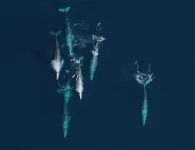(Press-News.org) UNIVERSITY PARK, Pa. — True altruism is rare behavior in animals, but a new study by Penn State researchers has found that honey bees display this trait. Additionally, they found that an evolutionary battle of genetics may determine the parent they inherit it from.
For the study, published in the journal Molecular Ecology, the researchers examined the genetics behind “retinue” behavior in worker honey bees, who are always female. After the worker bees are exposed to the queen bee’s pheromone, they deactivate their own ovaries, help spread the pheromone to the other worker bees, and tend to the queen and the eggs she produces.
This behavior is considered altruistic because it ultimately benefits the ability of the queen to produce offspring, while the worker bee remains sterile. For honey bees, the queen is typically the mother of all, or nearly all, the bees in the hive.
The researchers found that the genes that make worker bees more receptive to this pheromone — and therefore more likely to display the retinue behavior — can be passed down from either the mother or father bees. However, the genes only result in altruistic behavior when they are passed down from the mother.
Sean Bresnahan, corresponding author, doctoral candidate in the Intercollege Graduate Degree Program in Molecular, Cellular, and Integrative Biosciences and a National Science Foundation Graduate Research Fellow, said that in addition to giving insight into bee behavior, the findings also show that which parent a bee inherits certain genes from can affect how those genes are expressed, something that is notoriously difficult to study in insects.
“People often think about different phenotypes being the result of differences in gene sequences or the environment,” he said. “But what this study shows is it’s not just differences in the gene itself — it’s which parent the gene is inherited from. By the very nature of the insect getting the gene from its mom, regardless of what the gene sequence is, it’s possibly going to behave differently than the copy of the gene from the dad.”
Christina Grozinger, co-author and Publius Vergilius Maro Professor of Entomology at Penn State, said the study also supports the Kinship Theory of Intragenomic Conflict — a theory that suggests the mothers’ and fathers’ genes are in conflict over what behaviors to support and not support.
She said that while previous work has shown that genes from males can support selfish behavior in mammals, plants and honey bees, the current study is the first to show that genes from females can pass altruistic behavior onto their offspring.
“Honey bees are one of the few animal species that display altruistic behavior, where some individuals give up their own reproduction to help others,” Grozinger said. “This study reveals a very subtle and unexpected form of genetic control of those behaviors. With our system, we see that genes from the mother — the queen — are supporting altruistic behavior in her offspring, which leads to more copies of her genes in the population. Instead of producing their own eggs, the worker bees support the queen’s reproduction. This complements our previous studies, which showed that the fathers’ genes support selfish behavior in worker bees, where the bees will stop helping their queen mother and focus on their own reproduction.”
The queen mates with multiple males, so worker bees have the same mother but different fathers. Breshnahan explained that this means they share more of their mother’s genes with each other.
“This is why the Kinship Theory of Intragenomic Conflict predicts that genes inherited from the mother will support altruistic behavior in honey bees,” Breshnahan said. “A worker bee benefits more from helping, rather than competing with, her mother and sisters — who carry more copies of the worker’s genes than she could ever reproduce on her own. In contrast, in species where the female mates only once, it is instead the father's genes that are predicted to support altruistic behavior."
For the study, the researchers cross-bred six different lineages of honey bees — something that is relatively easy in mammals or plants, according to Bresnahan, but much harder to do with insects. He said the study wouldn’t have been possible without the honey bee breeding expertise of co-author Juliana Rangel at Texas A&M University, as well as Kate Anton who runs the Education about Production and Insemination of (honey bee) Queens program with Robyn Underwood at Penn State Extension.
After the bee populations were crossed and the offspring were old enough, the researchers assessed the worker bees’ responsiveness to the pheromone that triggers the retinue behavior, as well as whether the bees deactivated their ovaries in response to the pheromone.
“Finally, we used RNA sequencing to look at genome-wide gene expression in the workers, but importantly, we also sequenced the genomes of the parents of those crosses,” Bresnahan said. “So, we could develop personalized genomes for the parents, and then map back the workers’ gene expression to each parent and find out which parent’s copy of that gene is being expressed.”
To try to visualize this conflict happening within the genome, Bresnahan said they used different techniques including machine learning to examine gene regulatory networks, or groups of genes regulated by similar transcription factors to produce similar expression patterns. The researchers looked at relationships between genes and transcription factors — the proteins that can turn genes on or off — were expressed from the mom’s copy and those that were expressed from the dad’s copy to identify where one might try to counteract the effects of the other.
Ultimately, they were able to identify gene regulatory networks with intragenomic conflict, finding that more genes were expressed with a parental bias. This maternal- or paternal-originated expression bias is the signature of intragenomic conflict, and the researchers said it appeared more often than it would have if they had constructed the networks with randomly selected genes. Additionally, these networks consisted of genes that previous research showed were related to the retinue behavior.
“Observing intragenomic conflict is very difficult, and so there are very few studies examining the role it plays in creating variation in behavior and other traits,” Grozinger said, pointing to the groups prior research that revealed ovary activation and aggression in worker bees, both of which signify selfish behavior. “The fact that this is the third behavior where we have found evidence that intragenomic conflict contributes to variation in honey bees suggests that intragenomic conflict might shape many types of traits in bees and other species. Hopefully, our research will provide a framework and inspiration for other scientists to examine intragenomic conflict in their plant and animal species.”
David Galbraith, Penn State alumni and senior scientist at Janssen Pharmaceutical; Rong Ma, Penn State alumni and senior data scientist at Visa; Kate Anton, research technologist at Penn State; and Juliana Rangel, Texas A&M University, also collaborated on this work.
The National Science Foundation, U.S. Department of Agriculture’s National Institute of Food and Agriculture and Hatch Appropriations, and Huck Institute for the Life Sciences at Penn State helped support this research.
END
Honey bees may inherit altruistic behavior from their mothers
2023-10-12
ELSE PRESS RELEASES FROM THIS DATE:
Researchers develop technology to tabulate and characterize every cell in the human brain
2023-10-12
BOSTON – The brain is made up of numerous types of cells that are organized into different structures and regions.
Although several important steps have been made towards building models of the human brain, the advances have not produced undistorted 3D images of cellular architecture that are needed to build accurate and detailed models.
In new research published in Science Advances, a team led by investigators at Massachusetts General Hospital (MGH), a founding member of Mass General Brigham (MGB), has overcome this challenge to offer scientists and clinicians a comprehensive cellular atlas of a part of the human brain known as Broca’s area, with ...
Americans will spend half their lives taking prescription drugs, study finds
2023-10-12
UNIVERSITY PARK, Pa. — An American born in 2019 will spend a larger share of their lifetime taking prescription drugs than being married or receiving an education, according to new research by Jessica Ho, associate professor of sociology and demography at Penn State. She found that American males will spend approximately 48% of their lives taking prescription drugs. The number jumped to 60% for females.
Ho reported her findings this week (Oct. 1) in the journal Demography.
“As an American, I’d like ...
Advertising rental housing in Spanish puts off many potential renters
2023-10-12
Publishing an ad for an apartment or rental home in Spanish may seem like it would broaden the pool of potential renters, but new research shows it can harm rental-seekers’ perception of the property and its neighborhood.
Finding a new apartment or home to rent can be nerve-wracking and tedious. It is increasingly digital and there are thousands of websites and Facebook groups for prospective renters to peruse. It can be a fraught endeavor — from vetting Craigslist listings to scrolling through hundreds of different listings to find the ...
Scientists generate first single-cell “atlas” of the primate brain to help explore links between molecules, cells, brain function and disease
2023-10-12
A longstanding mystery in science is how the over 100 million individual neurons work together to form a network that forms the basis of who we are – every human thought, emotion and behavior.
Mapping these constellations of cells and discovering their function have been long-standing goals of scores of 21st century molecular cartographers working worldwide as part of the National Institutes of Health’s “Brain Initiative Cell Census Network” project. The overarching ...
Researchers construct first “multiome” atlas of cell development in the human cerebral cortex from before birth to adulthood
2023-10-12
A team of researchers from the Icahn School of Medicine at Mount Sinai and Yale University School of Medicine has created the first “multiome” atlas of brain cell development in the human cerebral cortex across six broad developmental time points from fetal development into adulthood, shedding new light on their roles during brain development and disease.
“Multiome” refers to the simultaneous analysis of multiple types of genetic information within the same biological sample. They can include the genome, the DNA encoded in our cells; the transcriptome, the RNA copies that the cell makes from the ...
Boom-and-bust cycles in grey whale population associated with changing Arctic ecosystem
2023-10-12
Even highly mobile, large, and long-lived species are sensitive to dynamic and changing conditions as the Arctic warms. A new study reports that population swings in eastern North Pacific grey whales – some of which have resulted in recent mass mortality events – are driven by changing prey biomass and ice cover in the Arctic. Climate change is driving rapid change in Arctic ecosystems, including the highly productive shallow basins of the Pacific Arctic, which are critical marine areas that support seasonal foraging opportunities for various migratory marine species. While climate impacts affect lower-trophic level and short-lived species most directly, ...
About 2 million years ago, Homo Erectus lived at high altitudes and produced both Oldowan and Acheulean tools
2023-10-12
Two million years ago, Homo erectus had expanded beyond the lowland savanna environments of East Africa and into the high-altitude regions of the Ethiopian highlands, where they produced both Oldowan and Acheulean tools, according to a new study. It presents a reanalysis of an early hominin fossil first discovered in 1981. The findings provide novel insights into the evolution, migration and adaptive capacities of early human ancestors. In Africa, the limited number of hominin fossils found in direct association with stone tools has hindered attempts to link Homo habilis and Homo erectus with ...
Engineered bacteria guide CAR-T cells to poorly infiltrated solid tumors
2023-10-12
A new probiotic-guided chimeric antigen receptor (CAR)-T platform uses engineered bacteria to infiltrate and produce synthetic antigen targets, enabling CAR-T cells to find, identify, and destroy tumor cells in situ, according to a new study. The combined cell therapy platform expands the scope of CAR-T cell therapy to include difficult-to-target solid tumors. Immunotherapies using CAR-T cells have proven successful in treating some types of blood cancers. However, their efficacy against solid tumors remains elusive. A key challenge facing tumor-antigen targeting immunotherapies like CAR-T is the identification of suitable ...
An electrical switch to control chemical reactions
2023-10-12
New pharmaceuticals, cleaner fuels, biodegradable plastics: in order to meet society’s needs, chemists have to develop new synthesis methods to obtain new products that do not exist in their natural state. A research group at the University of Geneva (UNIGE), in collaboration with Cardiff University, has discovered how to use an external electric field to control and accelerate a chemical reaction, like a ‘‘switch’’. This work, to be read in Science Advances, could have a considerable impact on the development of new molecules, enabling not only more environmentally friendly synthesis, but also very simple external control of a chemical reaction.
In ...
Gray whales experience major population swings as a result of Arctic conditions, research shows
2023-10-12
NEWPORT, Ore. – Dynamic and changing Arctic Ocean conditions likely caused three major mortality events in the eastern North Pacific gray whale population since the 1980s, a new study has found.
During each of these die-offs, including one that began in 2019 and is ongoing, the gray whale population was reduced by up to 25% over just a few years, said Joshua Stewart, an assistant professor with Oregon State University’s Marine Mammal Institute and the study’s lead author.
“These are extreme population swings that we did not expect to see in a large, long-lived species like gray whales,” Stewart said. “When the availability ...


